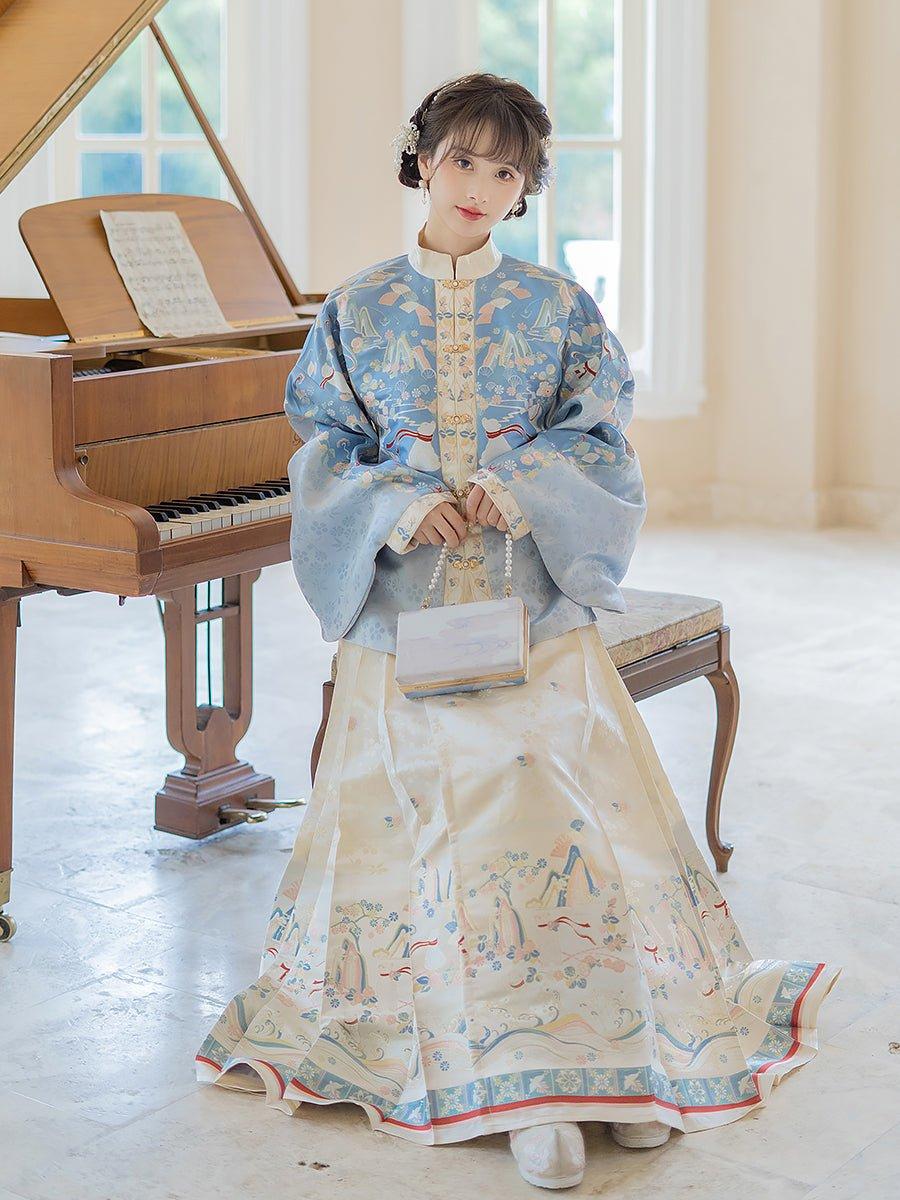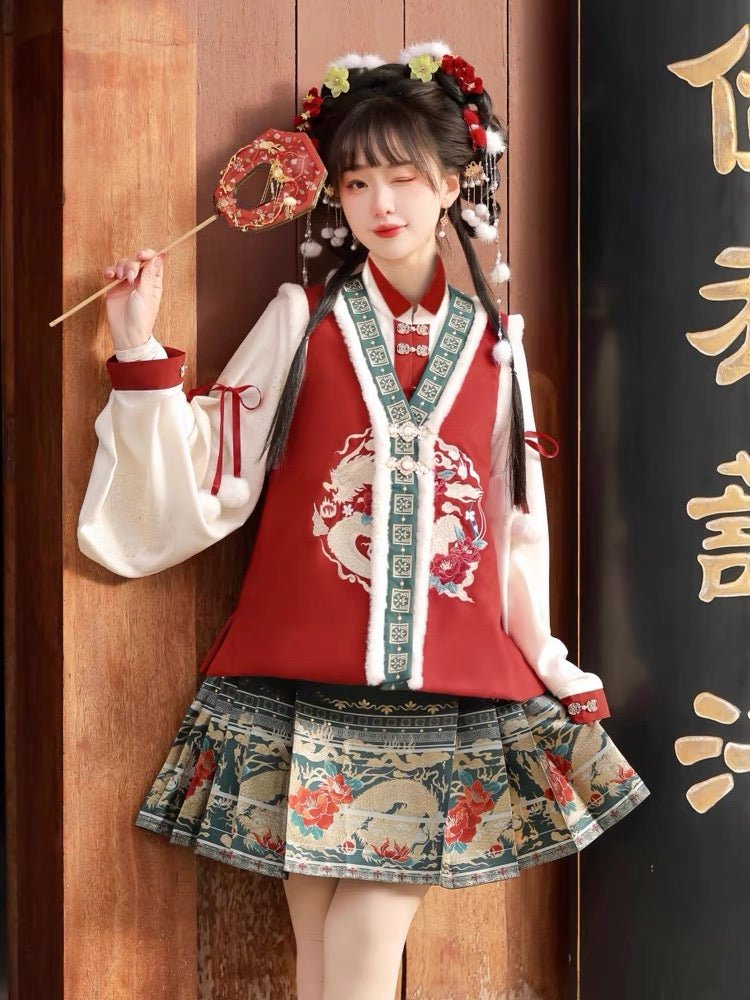You notice the shimmer of pearls stitched onto shoes and skirts in Song dynasty clothing shoes. Silk flows softly, giving each outfit a graceful look. Craftsmen select fine materials like linen and wool to create elegant styles. These choices show the values of Song society. Simple lines and light colors reflect a love for beauty and meaning. Fashion becomes more than clothing; it expresses culture.
1、Song dynasty clothing shoes key Takeaways
Song dynasty clothing uses fine materials like silk, linen, and wool, focusing on comfort and elegance.
The color palette features light tones, avoiding blue, which creates a calm and peaceful look.
Popular styles like the beizi and ruqun reflect modesty and respect, aligning with Confucian values.
Song Dynasty Shoes indicate social status, with officials wearing simple black leather and wealthy women choosing colorful, embroidered designs.
Song dynasty fashion influences Modern Hanfu, emphasizing harmony and subtle beauty in clothing.
2、Song Dynasty Clothing Shoes Overview
Materials and Fabrics
You can see that song dynasty clothing shoes use some of the finest materials available at the time. Craftsmen often choose silk for its smooth texture and gentle shine. Silk lets you move easily and keeps you cool in warmer weather. Linen and wool also appear in many garments. Linen feels light and comfortable, making it perfect for daily wear. Wool provides warmth during colder months. These materials show a focus on comfort and elegance. When you wear these clothes, you notice how the fabric drapes softly and allows for easy movement.
Song dynasty clothing shoes often feature delicate details, such as pearls sewn onto skirts and shoes. These decorations add a touch of luxury without being too flashy.
Colors and Patterns
The color palette of song dynasty clothing shoes stands out for its light and gentle tones. You will find off-white, brown, and black edges as common choices. These colors create a calm and peaceful look. Unlike the Ming dynasty, which uses darker colors like blue, the Song dynasty avoids blue completely. This choice makes the clothing feel softer and more relaxed.

▲The picture shows the Song-style Hanfu from the Yi Lu Collection of the Hanfu brand Wanshafang.
Lighter and subdued colors such as off-white and brown
Black edges for contrast
No blue, which sets Song dynasty apart from earlier and later periods
Patterns remain simple and elegant. You rarely see bold or busy designs. Instead, the focus stays on clean lines and subtle beauty. This style matches the values of the time, where people appreciate modesty and balance.(I think this is also the fundamental reason why Song-style Hanfu is increasingly sought after by contemporary people.)
Silhouettes and Styles
When you look at song dynasty clothing shoes, you notice the graceful shapes and simple lines. The most popular styles include ruqun and beizi. The beizi, a straight and loose outer garment, becomes a favorite for both men and women. Women often wear the beizi over long skirts, while men use it as informal home wear. The ruqun features a long, narrow skirt paired with a jacket that closes to the right. Pleated skirts become especially popular among upper-class women.

▲New Chinese-style clothing inspired by Hanfu beizi (outer garment) and ruqun (jacket-skirt set).
The beizi shows a straight silhouette, reflecting a love for simplicity and elegance.
The ruqun combines a fitted jacket with a flowing skirt.
Pleated skirts add texture and movement to the outfit.
These styles do more than just look nice. They also reflect the values of the Song dynasty. Simple and elegant clothing shows modesty and respect, which matches Confucian ideas of harmony and balance. The shenyi, a long robe, stands as a symbol of discipline and proper behavior. You can see how the practical yet refined style of these clothes makes them comfortable and easy to wear. This focus on moderation and respect shapes the way people dress and act.
3、Social and Cultural Significance
Status and Dress Codes
You can learn a lot about Song society by looking at what people wore. Clothing and shoes showed your place in the social order. If you belonged to the imperial family or nobility, you wore special garments and shoes that set you apart. For example, imperial concubines wore the ruqun, a skirt with unique designs and decorations. Nobles and military officials often chose cloud-patterned boots. These boots had beautiful embroidery and showed high status. Women from wealthy families sometimes wore lotus shoes, which were tiny and decorative.
Here is a table that shows how different types of clothing and shoes matched social class:
|
Clothing Type |
Social Class Indicator |
|---|---|
|
ganshangqun |
Worn by imperial concubines, showing high status |
|
Cloud-Patterned Boots |
Linked to nobility and military officials |
|
Lotus Shoes |
Worn by upper-class women with bound feet |
You also saw clear dress codes for different ranks and occasions. Empresses and noblewomen wore the "Hua (Dian) Chai Li Yi" for important ceremonies. The "Yi dress," "Yu Di dress," and "Que Di dress" used dark cyan fabric and pheasant patterns to show rank. These outfits included special accessories like large belts and aprons. Empresses and concubines had four formal dresses, each for a different event. Commoners and scholars wore simple cloth shoes, which showed their lower status.
Cloth shoes: Worn by commoners and scholars
Cloud-patterned boots: Worn by nobles and officials
Lotus shoes: Worn by upper-class women
Symbolism in Attire
Song dynasty clothing shoes did more than show status. They also carried deep meanings. Pearls, for example, became a popular decoration for all classes. When you saw pearls sewn onto garments, you knew the wearer wanted to show wealth and beauty. The 'Zhuluo' style, with pearls along the edges, made formal outfits look even more special. Pearls also appeared in idioms and stories, showing their cultural importance.For example, "珠联璧合" (Zhu Lian Bi He): which is like the combination of pearls and beautiful jades, metaphorically refers to the gathering of outstanding talents or wonderful things.
|
Symbolic Meaning |
Description |
|---|---|
|
Fashion Statement |
Pearls showed wealth and style for all classes |
|
Status Indicator |
The 'Zhuluo' style used pearls to highlight the wearer's status |
|
Cultural Significance |
Pearls symbolized luxury and beauty in Song society |
When you look at these details, you see how clothing and shoes helped people express who they were. Every choice, from the color of a robe to the style of a shoe, told a story about the person wearing it.
Song Dynasty Shoes
Construction and Materials
You can see that Song dynasty shoes use a variety of materials. Craftsmen often choose cloth, such as hemp, cotton, or silk, for most shoes. These materials feel soft and allow your feet to breathe. Silk shoes look smooth and shiny, while hemp and cotton shoes feel sturdy and comfortable. Some shoes use black leather, which gives a polished and formal look. You might notice that shoes for the elite include pearls or fine embroidery. These details show wealth and attention to beauty. For daily life, people prefer simple shoes with clean lines and little decoration.
Shoes from the Song dynasty focus on both comfort and style. You can walk easily in them, whether you work in the fields or attend a formal event.
Popular Styles
You will find many different shoe styles during the Song dynasty. Each style matches the needs and tastes of the people who wear them. Here are some of the most popular types:
Cloth shoes made from hemp, cotton, or silk
Black leather shoes for officials and scholars
Pearl shoes with delicate decorations for the wealthy
Embroidered silk shoes for women
Simple, practical shoes for commoners
Designs often feature clean lines and subtle patterns. Women's shoes stand out with bright colors and detailed embroidery. Scholar-gentry shoes look plain and black, showing modesty and respect for tradition.

▲The picture shows the women's Hanfu shoes from the Green Spring Collection of the Hanfu shoe brand Jiangnan Zhuji.
Shoes for Different Groups
Shoes in the Song dynasty tell you a lot about the person wearing them. Officials and scholars usually wear black leather or cloth shoes. These shoes look simple and do not have much decoration. This style matches their values of modesty and discipline. Women from rich families wear colorful silk shoes with embroidery or pearls. These shoes show their family's wealth and their own sense of beauty. Commoners choose practical shoes made from hemp or cotton. These shoes last a long time and work well for daily tasks.

▲The picture shows the women's Hanfu shoes from the Zhu Ying Collection of the Hanfu shoe brand Jiangnan Zhuji.
|
Group |
Typical Shoe Type |
Features |
|---|---|---|
|
Officials |
Black leather or cloth shoes |
Simple, unadorned, formal |
|
Women (elite) |
Silk or pearl-decorated shoes |
Colorful, embroidered, elegant |
|
Commoners |
Hemp or cotton cloth shoes |
Durable, practical, plain |
When you look at song dynasty clothing shoes, you see how each pair reflects the wearer’s role in society. Shoes become more than just something to wear—they show status, taste, and tradition.
Comparison with Other Dynasties
Differences from Tang and Ming
You can spot clear differences when you compare Song dynasty clothing and shoes with those from the Tang and Ming dynasties. Each era has its own style and rules.
Tang Dynasty: You see bright colors and lots of silk, especially for nobles. Women wear long-sleeved shirts with wide sleeves and flowing skirts. Men choose solid-colored robes with rounded collars. The look feels bold and lively.

▲The picture shows the Hanfu from the Sheng Tang Shao Zhu Collection of the Hanfu brand Qinghanfang.
Ming Dynasty: You notice styles that look like those from the Han dynasty. Modesty becomes important. Women wear midi-length garments over floor-length skirts. Men pick square collars with embroidered designs to show their social class. The style feels more reserved and formal.

▲The picture shows the Hanfu from the Mid-Autumn Collection of the Hanfu brand Yunzangyuexiu.
Song dynasty clothing stands out for its gentle colors and simple lines. You find less decoration and more focus on comfort. Shoes also look different. Song shoes use pearls and embroidery for elegance, while Tang shoes often match the boldness of their clothes. Ming shoes follow strict dress codes and show rank with special designs.
When you look at these dynasties side by side, you see how fashion reflects the values and tastes of each period.
Unique Song Dynasy Innovations
You discover special innovations in Song dynasty clothing and shoe design. The bèizi garment becomes a key example. Craftsmen change the bèizi from the Tang dynasty’s bànbì. They make it longer, add full sleeves, and use a straight collar. Side slits start below the armpits, which helps you move more easily. This design shows how Song fashion values both practicality and elegance. You notice that elite women wear bèizi with fine details, while working women choose simpler versions. Song designers create shoes with pearls and embroidery, making them both beautiful and comfortable. These changes set Song dynasty styles apart from earlier and later periods.
Lasting Influence
Impact on Later Fashion
You can see the influence of Song dynasty clothing in many styles that came after. The Song dynasty set new standards for elegance and color matching. Designers from later periods often followed the Song principle of harmony and subtlety. The shirt and skirt outfit became a basic style in Chinese fashion. People started to match colors carefully, using the idea of "light on top and bright on the bottom." This approach made outfits look balanced and pleasing.
Today, you still find Song dynasty elements in modern Chinese fashion. Designers and artists draw inspiration from these ancient styles.For example, internationally renowned fashion events such as Paris Fashion Week and the Metropolitan Museum of Art in New York have featured related elements and design inspirations.
The 'Made in China' exhibition shows modern clothes that use Song dynasty shapes and details.
You might notice heels by Denise Huang, which take ideas from imperial Song costumes. These shoes blend old traditions with new designs.
You can see how Song dynasty fashion continues to shape what people wear, both in China and around the world.
How might these timeless designs inspire what you wear today?
That's all for our introduction to song dynasty clothing shoes. Due to the length, I will compile a dedicated FAQ about song dynasty clothing shoes, listing as many questions as possible for your reference. Stay tuned!
At the end of the article, I'd like to recommend a product compilation video of "Jiangnan Zhuji"—a Song Dynasty Hanfu shoe brand that I personally love. I hope you'll like it too.




